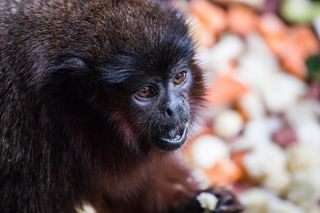Ancient Monkey Transformed into a 'Sloth' When It Arrived in Jamaica

About 10 million years ago, a family of monkeys left the South American mainland on a cruise to Jamaica and, as is still the case for so many tourists today, swiftly fell for the lazy pace of island life. Over many generations, the primates' legs evolved for slow climbs up tropical trees, their mouths grew a few giant molars at the expense of other, tinier teeth and — apparently unburdened by natural predators — the chilled-out tree dwellers spent their days living more like sloths than monkeys.
These strange Jamaican sloth-monkeys, better known as Xenothrix mcgregori, are real (at least, they were; they've been extinct for at least 900 years). And while there is no scientific dispute that these primates were among the oddest ever to grace the Western Hemisphere, there is little consensus on how they got there in the first place, and who their ancestors were. [Wipe Out: History's Most Mysterious Extinctions]
Now, a new study published Nov. 12 in the journal Proceedings of the National Academy of Sciences offers the first major evidence that the ancestors of Jamaica's X. mcgregori monkeys may have been accidental colonists from South America.
In the new study, an international team of zoologists from the U.K. and the U.S. analyzed DNA samples taken from two X. mcgregori leg bones dated to about 1,500 years ago. With help from the Natural History Museum in London's Ancient DNA Laboratory, the researchers mapped the X. mcgregori's genome and compared it with a selection of other extinct Caribbean primates as well as monkeys still living on the South American mainland.
The analysis revealed that X. mcgregori's closest relatives belong to a subfamily of South American primates called titi monkeys (Callicebinae) — a small breed of active, territorial tree-dwellers that still inhabit a large swath of South American forests.
"Ancient DNA indicates that the Jamaican monkey is really just a titi monkey with some unusual morphological features, not a wholly distinct branch of New World monkey," study co-author Ross MacPhee of the American Museum of Natural History's Department of Mammalogy, said in a statement. "Evolution can act in unexpected ways in island environments, producing miniature elephants, gigantic birds and sloth-like primates."
The titi and X. mcgregori monkeys likely diverged around 11 million years ago, the researchers wrote, which provides some further clues as to how the X. mcgregori ended up chilling on Jamaica while their cousins toughed it out in the rainforest. Because there was no overland path between South America and Jamaica at the time, groups of titi-like monkeys probably floated there accidentally on rafts of vegetation washed out of South America's large rivers, the authors wrote. Once those seafaring monkeys arrived in Jamaica, they colonized it, adapting to their new habitat over a few million years before, ultimately, going extinct due to human encroachment.
Sign up for the Live Science daily newsletter now
Get the world’s most fascinating discoveries delivered straight to your inbox.
"The extinction of X. mcgregori, which evolved on an island without any native mammal predators, highlights the great vulnerability of unique island biodiversity in the face of human impacts," study co-author Samuel Turvey, of the Zoological Society of London, said in the statement.
In this regard, X. mcgregori might not have been alone. Fossilized remains of various other unique Caribbean monkey species have been dated to as far back as 18.5 million years ago, suggesting there were multiple groups of primate "colonists" that landed on various Caribbean islands over the centuries, the authors wrote. When will these bold Primates of the Caribbean™ get the media franchise they deserve?
- Image Gallery: Cute Gelada Monkeys
- Image Gallery: Adorable Vervet Monkeys Conform to Peers
- Photos: The Monkeys of Brazil's Atlantic Forest
Originally published on Live Science.

Brandon is the space/physics editor at Live Science. His writing has appeared in The Washington Post, Reader's Digest, CBS.com, the Richard Dawkins Foundation website and other outlets. He holds a bachelor's degree in creative writing from the University of Arizona, with minors in journalism and media arts. He enjoys writing most about space, geoscience and the mysteries of the universe.
